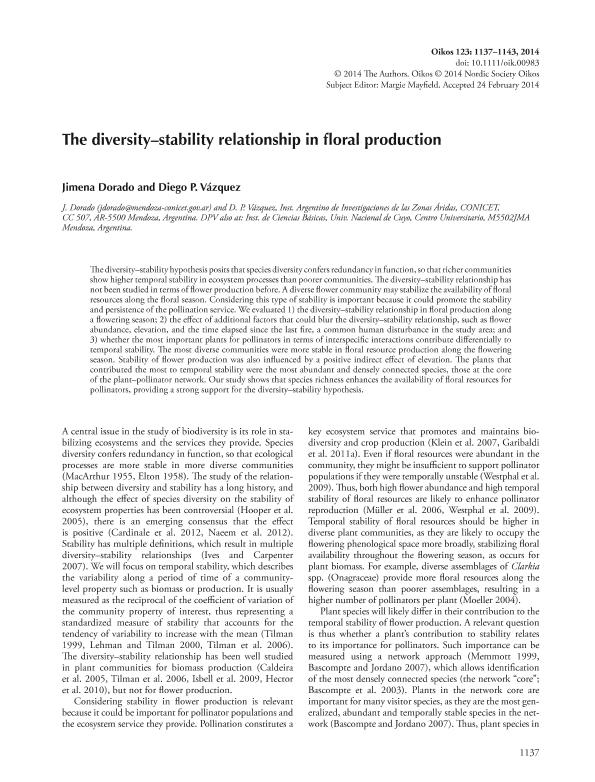Mostrar el registro sencillo del ítem
dc.contributor.author
Dorado, Jimena

dc.contributor.author
Vazquez, Diego P.

dc.date.available
2018-01-17T21:35:47Z
dc.date.issued
2014-04
dc.identifier.citation
Dorado, Jimena; Vazquez, Diego P.; The diversity–stability relationship in floral production; Wiley; Oikos; 123; 9; 4-2014; 1137-1143
dc.identifier.issn
0030-1299
dc.identifier.uri
http://hdl.handle.net/11336/33731
dc.description.abstract
The diversity–stability hypothesis posits that species diversity confers redundancy in function, so that richer communities show higher temporal stability in ecosystem processes than poorer communities. The diversity–stability relationship has not been studied in terms of flower production before. A diverse flower community may stabilize the availability of floral resources along the floral season. Considering this type of stability is important because it could promote the stability and persistence of the pollination service. We evaluated 1) the diversity–stability relationship in floral production along a flowering season; 2) the effect of additional factors that could blur the diversity–stability relationship, such as flower abundance, elevation, and the time elapsed since the last fire, a common human disturbance in the study area; and 3) whether the most important plants for pollinators in terms of interspecific interactions contribute differentially to temporal stability. The most diverse communities were more stable in floral resource production along the flowering season. Stability of flower production was also influenced by a positive indirect effect of elevation. The plants that contributed the most to temporal stability were the most abundant and densely connected species, those at the core of the plant–pollinator network. Our study shows that species richness enhances the availability of floral resources for pollinators, providing a strong support for the diversity–stability hypothesis.
dc.format
application/pdf
dc.language.iso
eng
dc.publisher
Wiley

dc.rights
info:eu-repo/semantics/openAccess
dc.rights.uri
https://creativecommons.org/licenses/by-nc-sa/2.5/ar/
dc.subject
Plant-Pollinator Interactions
dc.subject
Species Diversity
dc.subject
Community Stability
dc.subject
Flowering
dc.subject.classification
Otras Ciencias Biológicas

dc.subject.classification
Ciencias Biológicas

dc.subject.classification
CIENCIAS NATURALES Y EXACTAS

dc.title
The diversity–stability relationship in floral production
dc.type
info:eu-repo/semantics/article
dc.type
info:ar-repo/semantics/artículo
dc.type
info:eu-repo/semantics/publishedVersion
dc.date.updated
2018-01-03T19:58:57Z
dc.journal.volume
123
dc.journal.number
9
dc.journal.pagination
1137-1143
dc.journal.pais
Estados Unidos

dc.journal.ciudad
Hoboken
dc.description.fil
Fil: Dorado, Jimena. Consejo Nacional de Investigaciones Científicas y Técnicas. Centro Científico Tecnológico Conicet - Mendoza. Instituto Argentino de Investigaciones de las Zonas Áridas. Provincia de Mendoza. Instituto Argentino de Investigaciones de las Zonas Áridas. Universidad Nacional de Cuyo. Instituto Argentino de Investigaciones de las Zonas Áridas; Argentina
dc.description.fil
Fil: Vazquez, Diego P.. Consejo Nacional de Investigaciones Científicas y Técnicas. Centro Científico Tecnológico Conicet - Mendoza. Instituto Argentino de Investigaciones de las Zonas Áridas. Provincia de Mendoza. Instituto Argentino de Investigaciones de las Zonas Áridas. Universidad Nacional de Cuyo. Instituto Argentino de Investigaciones de las Zonas Áridas; Argentina
dc.journal.title
Oikos

dc.relation.alternativeid
info:eu-repo/semantics/altIdentifier/url/http://onlinelibrary.wiley.com/doi/10.1111/oik.00983
dc.relation.alternativeid
info:eu-repo/semantics/altIdentifier/doi/http://dx.doi.org/10.1111/oik.00983
Archivos asociados
